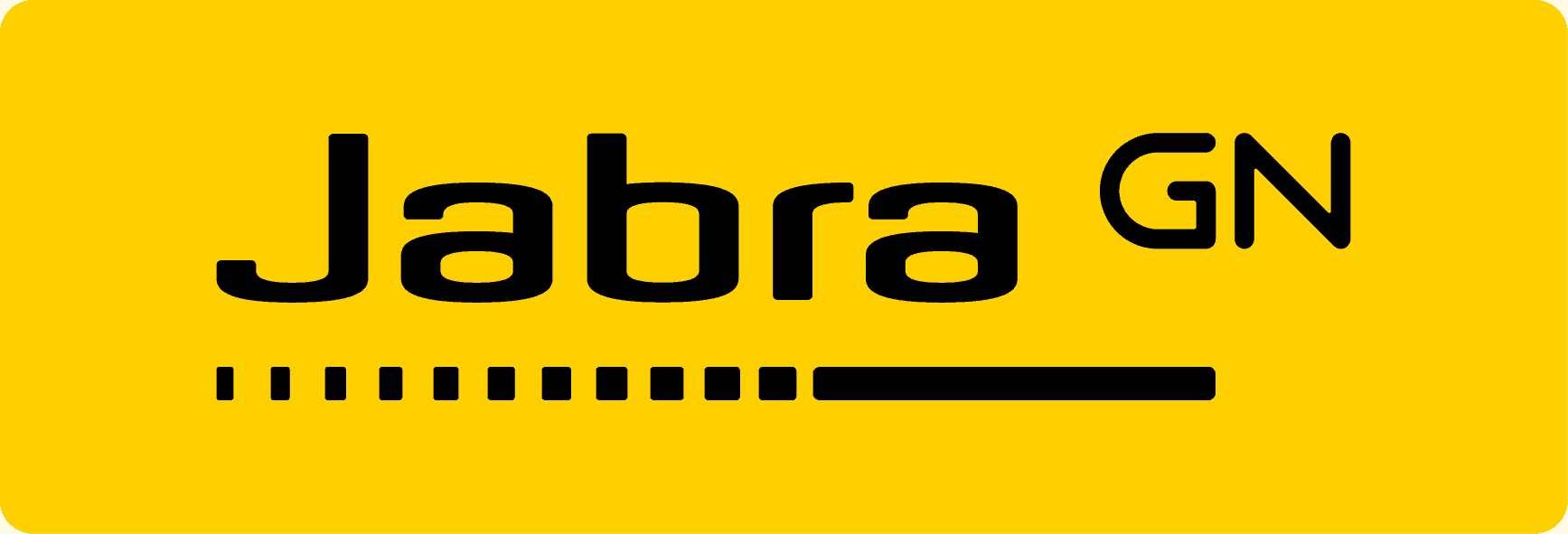Miracle-Ear Hearing Aid Reviews
Miracle-Ear offers solutions for mild to moderate hearing loss with lifetime support and thousands of nationwide locations.
SeniorLiving.org is supported by commissions from providers listed on our site. Read our Editorial Guidelines
SeniorLiving.org is supported by commissions from providers listed on our site. Read our Editorial Guidelines
Throughout my career as an audiologist, I’ve had the opportunity to work directly with several manufacturers and distributors. Knowing a company “behind the curtain” can provide further perspective on its inner workings. In 2008, I worked directly with Miracle-Ear to develop a standard protocol for fitting hearing aids using Probe Microphone Measurements (also called Real Ear). It’s a recommended verification method by the American Academy of Audiology (AAA) and the American Speech-Language-Hearing Association, but only done by about 30 percent of audiologists.1
Miracle-Ear recognized that doing this was the best practice and implemented the protocol. I modified the AAA guideline to align with Miracle-Ear’s software and hearing aid configurations. I trained several hundred owners and dispensers, which improved the results for thousands of hearing aid wearers.
Did You Know? While Miracle-Ear has some great hearing aids to consider, the brand didn’t make our list of the best hearing aids. Want to find out which providers we included? Check out our list of the best hearing aid brands.
I thought their current product line was made by Signia, based on a careful examination of the pictures on Miracle-Ear’s website. A few emails with corporate staff confirmed this. That is excellent news for potential customers, as these are very well-designed hearing aids with a feature set that has met the needs of most of my patients. Miracle-Ear excels in local service and customer relationships that are crucial to hearing care.
Why would you buy from Miracle-Ear if the hardware is made by Signia? I can think of several reasons. First, there may be a Miracle-Ear location very close to you. After all, there are more than 1,400 franchise locations in the United States (as well as several in Canada). For many people with hearing loss, particularly those with more severe losses, being “off the air” is terrifying. Having your provider close by is usually a great comfort. Second, many folks are long-time Miracle-Ear customers. For them, it’s less about the hearing aid itself and more about the service they get and their relationship with their provider. Third, even though the BTE products are made elsewhere, the company and the custom products are American, which is important to several folks. For this review, I’ll explain the Miracle-Ear product line and my experience with the devices.
Is Miracle-Ear Right for Me?
Miracle-Ear is an excellent choice if you’re looking for a provider with stellar customer service or options for any level of hearing loss. If you’re on a tight budget, just know there are many cheaper options for mild-to-moderate hearing loss. Check out our favorite budget-friendly providers below to learn more.
Styles and Technologies
Miracle-Ear offers many different styles of hearing aids, each with its own technology. Some of Miracle-Ear’s most popular models include:
Direct to iPhone Devices (Miracle-EarCONNECT)
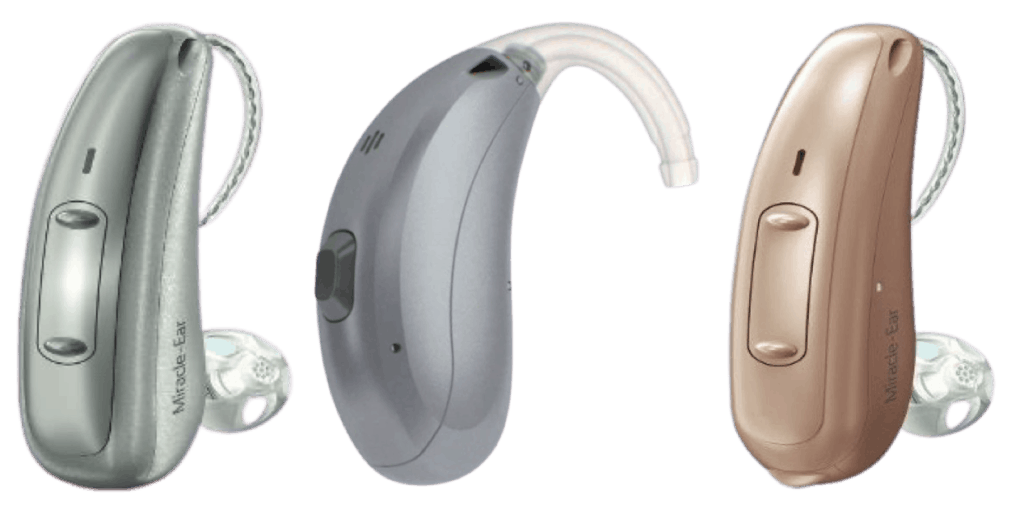
Miracle-EarCONNECT Devices – Receiver In Canal (left), Behind The Ear (middle), and Telecoil (right)
Thanks to Bluetooth technology, these devices can connect and stream audio directly to iOS devices (iPhone, iPad, iPod), making them best for those who want to connect their hearing aids to an iPhone. This technology is available in both a Receiver In Canal (RIC) and Behind The Ear (BTE) form factor. Both the BTE and RIC models use disposable batteries. Both provide coverage for various hearing loss configurations, from mild to severe. Telecoil is available on some models.
While they all provide some degree of automatic processing and directional microphones, there are differences across the price range of the number of adjustment channels and how the hearing aids process background noise.
Rechargeable Devices (Miracle-EarENERGY)
Miracle-Ear offers the same styles and technology – with rechargeable batteries. These rechargeable devices are best for those who have difficulty changing out small disposable batteries or don’t want to hassle with changing power cells every week. Signia provides the tech under the hood for Miracle-Ear hearing aids. The company is a leader in rechargeable technology, so Miracle Ear’s partnership provides extra benefits for customers who want to “plug and play” their hearing aids.
This group of devices includes the “iRIC R” hearing aid, which has a unique size and shape. It’s identical to the Signia Styletto, which I compared to early body-worn hearing aids cleverly disguised as jewelry. The ENERGY iRIC links more like a True Wireless headset than a hearing aid, which I believe will appeal to younger users who want high-tech connectivity and a device that doesn’t look like their grandfather’s hearing aid.
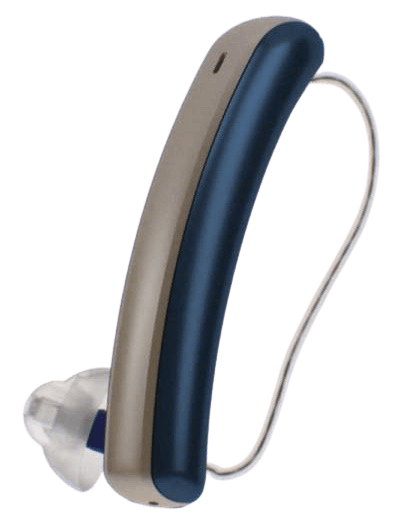
Miracle-EarENERGY iRIC R
This group of devices includes the “iRIC R” hearing aid, which has a unique size and shape. It’s identical to the Signia Styletto which I compared to early body-worn hearing aids that were cleverly disguised as jewelry. The ENERGY iRIC links more like a True Wireless headset than a hearing aid which I believe will appeal to younger users who want not only high tech connectivity but also a device that doesn’t look like their grandfather’s hearing aid.
Custom Products (Miracle-EarMINI)
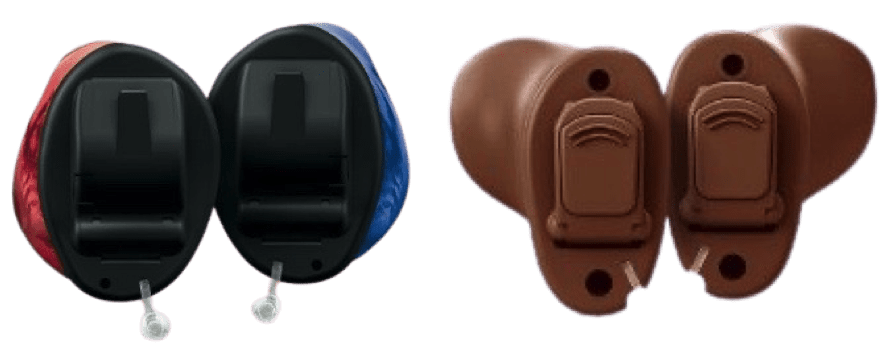
MEMINI IIC (left) and MEMINI CIC (right) Devices
Miracle-Ear offers an invisible-in-the-canal (IIC) model called the Mirage IIC, and a completely-in-the-canal (CIC) model called the Mirage CIC. Both use a #10 Zinc Air battery. These models are best for those who want a more discreet, in-ear solution. The devices have the same amplification technology as the above products across the price range. For those needing a lower price point, the MeMINI Audiotone Pro CIC provides a more entry-level feature set that should cover folks with mild to moderate losses. As the name implies, the circuit was made for Miracle-Ear by Audiotone and assembled by Miracle-Ear in Minnesota.
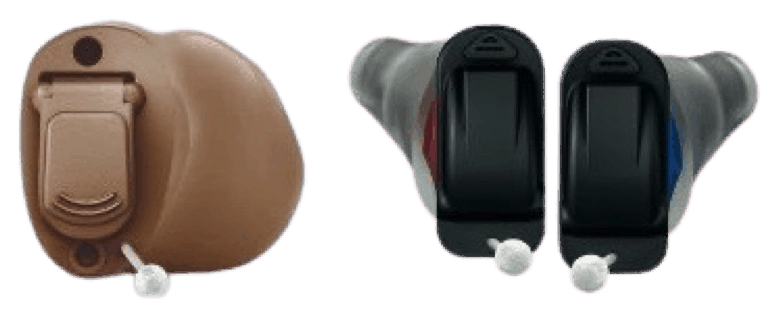
AudioTone Pro CIC (left) and MEMINI Ready Fit (right) Devices
Custom hearing aids need to be made to order. The shells are 3D printed from a casting of your ear (called an ear impression) and take several days to a couple of weeks to fabricate. If you want a CIC but don’t have time to wait, Miracle-Ear offers a “Ready-Fit” version of the ME MINI. The electronics are the same as the MEMINI CIC, but it uses a series of silicone sleeves to obtain a seal to your ear. It’s a good option if you have an “average” ear canal shape.
One caveat on CIC hearing aids from all manufacturers. Because of the small size, these devices almost always have one microphone, compared to two on the BTE and RIC models. Even though the placement deep in the ear provides some natural directionality, the ability to separate speech from background noise, especially when the speech is in front, is limited. Because of this, I recommend that all patients considering a CIC ask for a speech-in-noise test like the Quick SIN before finalizing the deal. The CIC will likely be a great solution if you have a mild “SNR Loss” on that test. If your difficulty with noise is moderate to severe, you’ll do much better with a discreet RIC like the CONNECT 312 or ENERGY iRIC.
Need Help Finding the Right Hearing Aid?
Answer a few easy questions to find the hearing aid that’s right for you.
Accessories
Even the best hearing aids cannot completely overcome the negative effects of distance, reverberation, and background noise. Miracle-Ear offers several accessories to assist.
Inductive Charger
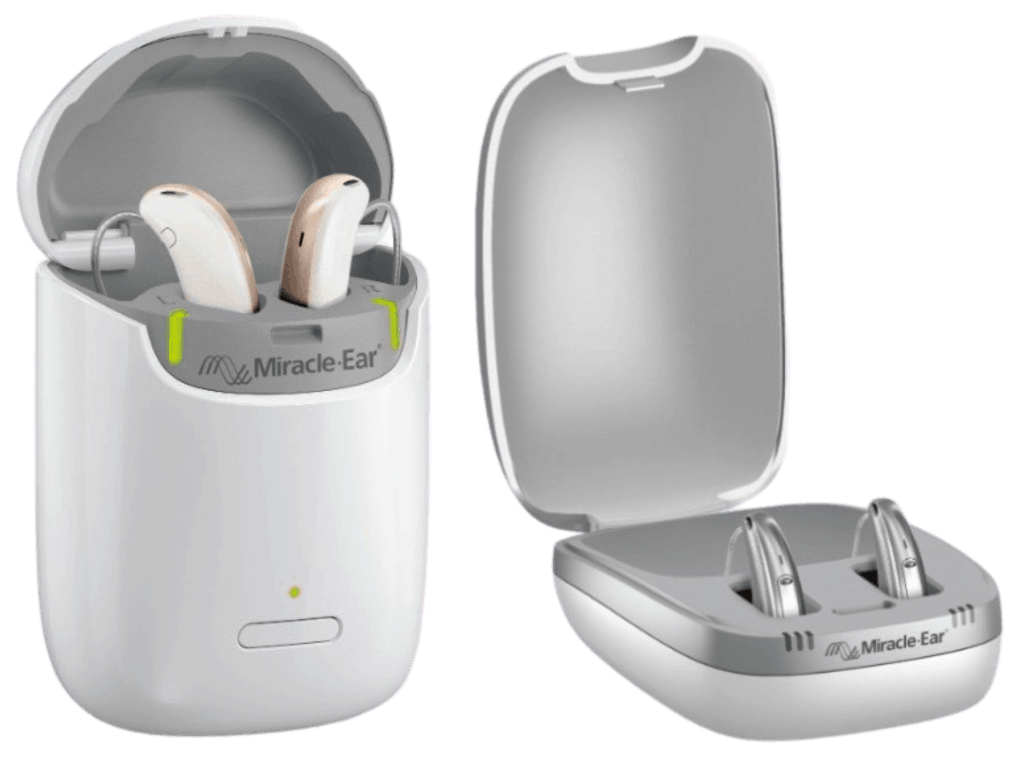
Miracle Ear Travel Charger (left) and Inductive Charger (right)
This compact and portable charger offers a quick or full charge for rechargeable hearing aids. For these on the go, they also offer a travel charger that can store several charges worth of power for unplugged charging. That is also very helpful for patients in areas like Florida, where hurricane season makes power outages common.
Audio Clip
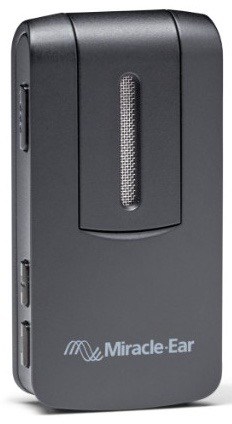
Miracle Ear Audio Clip
This device, about the size of a Zippo lighter, is a combination remote, microphone, and Bluetooth rebroadcaster. The remote microphone captures a speaker's voice (ideally used clipped on their shirt or lapel) and wirelessly sends the signal to your hearing aids. It allows your hearing aids to stream audio and phone calls from Android devices like cell phones and tablets in Bluetooth mode.
TV Streamer
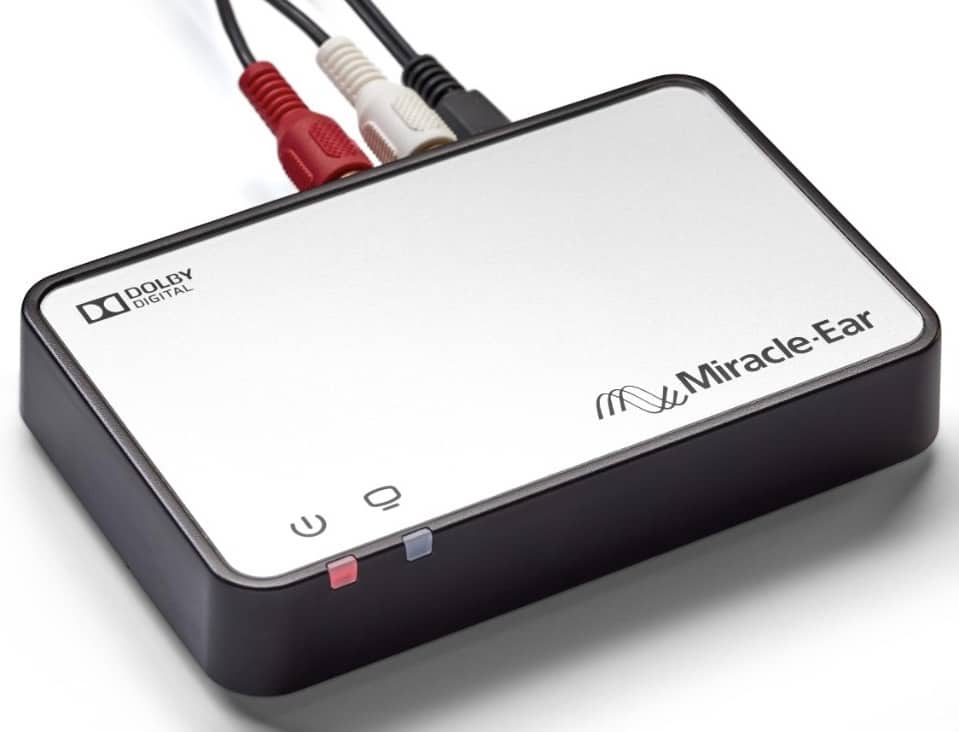
Miracle Ear TV Streamer
When connected to the audio output (analog or digital) of your TV or cable box, this streams the sound directly to your hearing aids, allowing others to adjust the TV volume to their comfort. That also allows for silent (mute) listening if you and your partner have different TV tastes.
Smartphone App

Miracle Ear Smartphone App
The app allows patients to adjust volume, set programs, and even request appointments with their provider. iOS users will pair their hearing aids using the Apple “MFI Hearing Devices” accessibility feature. Android users will use a set of ultra-high frequency “chirps” to tell the hearing aids what’s adjusted on the app.
Miracle-Ear Pricing
While Miracle-Ear does not list prices online, hearing aids can cost anywhere from $1,000 to $4,000. You must visit a hearing clinic in person to get exact pricing information. Some customer reviews mention that Miracle-Ear devices can be pricey, but the quality is worth the cost. The lack of pricing transparency is typical among leading brands I’ve reviewed and dispensed, such as Phonak hearing aids. If you want more pricing information upfront, you may want to consider over-the-counter hearing aids, such as Eargo and Jabra Enhance. Visit our Jabra Enhance review and Eargo review to learn more.
Customer Reviews and Ratings
Miracle-Ear customers often give the company five-star ratings and speak positively about their listening experience since purchasing the hearing aids. Many reviewers say that the company’s hearing specialists offer excellent care, providing vital insights and recommendations for their needs. Another common theme among customer reviews is that customers never felt pressure to purchase the most expensive styles, and the staff went above and beyond to help them pick the best hearing aids for their hearing loss.
Summary
As one of the most well-recognized brands of hearing aids, Miracle-Ear has a long history of providing quality products to folks with hearing loss. One of their most famous customers was Ronald Reagan, one of the first celebrities to go public about using hearing aids. They offer a wide range of very high-quality hearing aids and accessories. They have established themselves as an American company with longevity and a commitment to being part of the communities they serve. Their current tech is all made by Signia and Audiotone, but the service is all Miracle-Ear. Miracle-Ear is worth looking into for those looking to hear well and establish a local relationship with their provider. My only reservation is that because of the proprietary nature of the line. If you move, you may find it challenging to find someone to adjust and service instruments purchased at another franchise location.
Take Our Free Online Hearing Test
Wondering if you have hearing loss?
Grab your headphones and get an evaluation in minutes.
Mueller GH. (2005) Probe-mic measures: Hearing aid fitting’s most neglected element.

